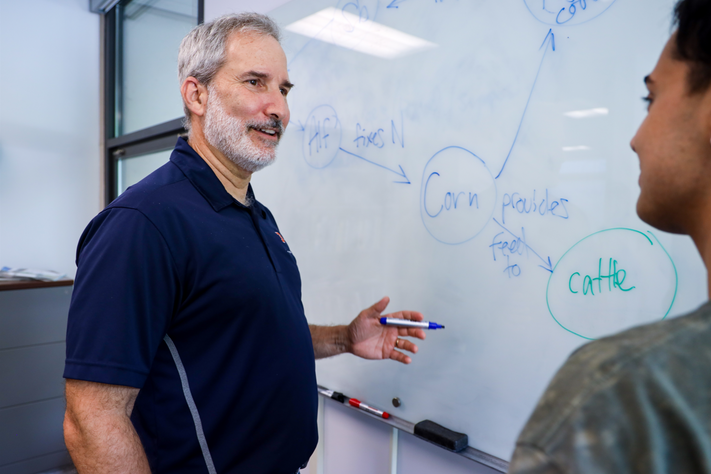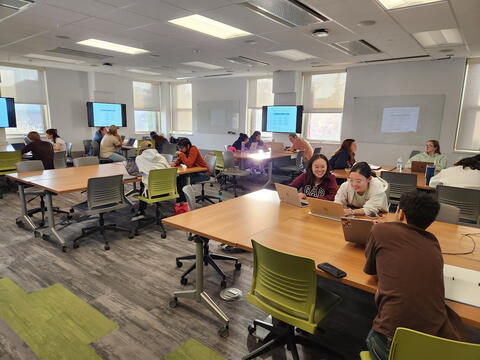More than memorization: How a Crop Sciences class cultivates systems thinkers

If you peek into a Turner Hall classroom at the end of the semester, you might see something unusual.
“It’s when you plant one thing, then another, then–”
“Crop rotation!”
“Correct. Next. Um… you have lots of places to live. But they’re all broken up.”
“Landscape mosaic?”
“No, close, you want them to be together–”
“Habitat connectivity!”
In this class run by Professor Adam Davis, the students are playing an agroecology guessing game. It’s one of many hands-on, creative activities that Davis uses to connect the world of farming to that of environmental sciences, supporting ACES’ mission of delivering a world-class experiential education.
Bringing innovation from the field to the classroom
Davis is head of the Department of Crop Sciences, part of the College of Agricultural, Consumer, and Environmental Sciences. He’s an outstanding instructor, repeatedly rated as excellent by his students. He’s also an internationally recognized scholar of agroecology, which he describes as a way of seeing the world.
“Agroecology takes the tools of ecology, thinking about interactions between living and nonliving systems, and then allows you to apply those to the practices and goals of agriculture,” he explained. This lens plays a critical role in the future of sustainable food production, a major research aim in the college. For example, Davis’ research found weeds could be managed using diverse cropping systems, reducing the need for pesticides and fertilizers.
Davis and M. B. Villamil, professor of crop sciences and Latin American and Carribean Studies, began teaching Principles of Agroecology, an advanced crop sciences class, in 2010. Davis became the sole instructor in 2014, and has been revising the course every year since.
Because agriculture and ecology are usually considered separate disciplines, blending the two challenges students who are usually trained in one or the other. So Davis had to get inventive.
In some ways, the class isn’t that unusual. Davis guides students through agroecological research and case studies, investigating everything from seeds hidden in earthworm burrows to the problems facing global food systems. But there are no exams — except for a few quizzes — and assignments are creative and open-ended.
“I'm interested in letting students explore their own relationships to agricultural systems through this agroecology lens,” Davis said. “And I want to give them the tools to come to their own conclusions.”
Davis wants students to ask questions about agroecosystems, not just remember facts and figures. In other words, his objective is to get students thinking agroecologically.
Thinking like an agroecosystem

Davis starts by throwing students in the deep end: the first class exercise asks them to plot agroecological processes according to space and time scales. For example, a crop rotation might take place over a few years across a couple of square miles, whereas the smallest soil particles can take hundreds of years to form. The exercise develops students’ big-picture, contextual understanding of agroecology, and unsurprisingly, many find it confusing and intimidating at first.
“Those space-time axes freak people out,” Davis laughed. But that’s the point, he says; assignments like these push students to be resourceful and self-reliant. “People are like, ‘What is he doing?!’ And then they start to get up to the board and try things out. I really like that cultural shift as they begin to just let go.”
As students’ confidence and knowledge grow, Davis ups the challenge, asking them to solve real-world problems. For one homework assignment, students design an imaginary livestock operation and create a sustainable manure management plan. In another, they predict weed population changes based on environmental factors.
The assignments allow students to practice mathematical modeling skills that farmers and ecologists actually use. “But I didn't want to just lecture on that,” Davis said. “I wanted students to experience how they can change parts of the model and then look at how the outcomes change.”
By tinkering with virtual agroecosystems, represented in spreadsheets or hand-drawn maps, students develop a sense for what works and what doesn’t. It helps them gain deeper insights than what a lecture or reading could provide.
Student success in class and beyond
Having developed a toolbox of skills for understanding agroecosystems, the students really get a chance to shine in their final projects. The class attracts undergraduate and graduate students from across the university, so each team represents a wide variety of educational and cultural backgrounds.
“It's intentional,” Davis said. “I'm an outsider to agriculture. It's been a continual exercise in trying to understand how people are communicating within the context of where they come from. The class is also designed to provide that experience.”
A single team meeting might include anecdotes from a suburban naturalist, stories from multigenerational farming families in the heart of Illinois, and memories from a grandparent’s vegetable farm in China, as students rely on each other to fill gaps in their cultural and practical knowledge.
In addition to growing their communication skills, the final projects allow students to pursue their personal, academic, and professional interests. Some students develop reports on sustainable farming methods, for instance, while others research barriers to implementing those practices.
Former doctoral student Kevin Wolz had already co-founded the Savannah Institute, a Champaign-based agroforestry nonprofit, when he took the class. For his final project, he wrote a Sustainable Agriculture Research and Education grant. He secured the funding, allowing the institute to plant its first plot. Wolz is now a guest speaker in Davis’ class, coming back to share insights and career opportunities with current students.
Davis’ challenging yet approachable style and the relevance of his course keep the class roster full. The class usually runs every other year, but starting in Fall 2025, Principles of Agroecology will run every fall. Davis hopes to expand the class capacity from 25 students to 35, and is excited to continue mentoring the university’s next generation of agricultural innovators and communicators.
“I have a lot of fun teaching and meeting the students,” Davis said. “And it’s a privilege to interact with smart young people who are interested in things.”
Interested students can register for CPSC 437 Principles of Agroecology, which fulfills course requirements for several ACES degree programs.
To support transformative education in crop sciences, see the department's Experiential Learning Fund.